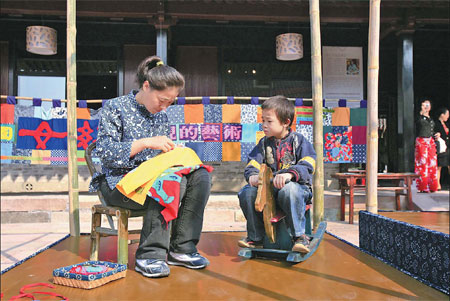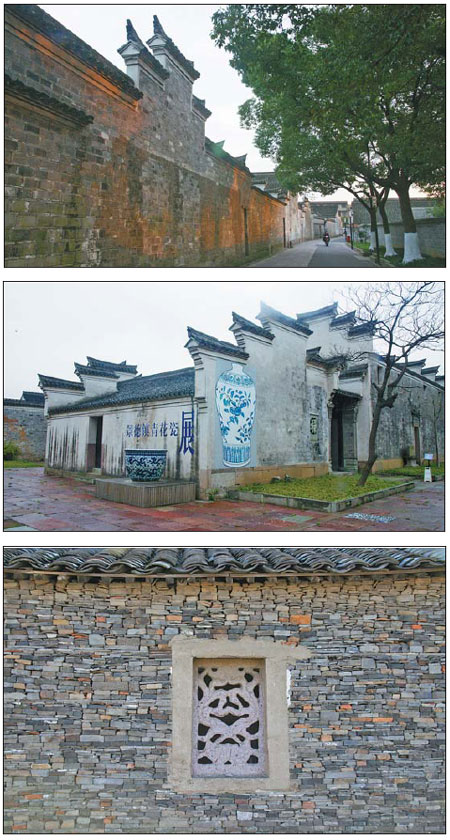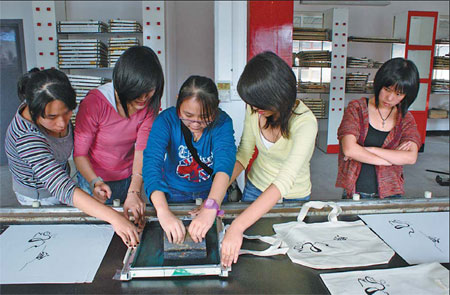Past crafts the Town's present and Future
Updated: 2013-10-11 09:55
By Sun Yuanqing (China Daily)
|
|||||||||||
Ancient settlement near ningbo hopes to lure designers with its exquisite culture of handicrafts
It is 38 C outside, and the heat in the ancient wooden house is stifling. But the crowd keeps moving from one exhibition hall to another, frequently stopping to take a closer look at the exhibits on display.
Among them is Wang Weidong, president of the womenswear label Broadcast. Wang has come to Cicheng, near Ningbo, about two hours' drive from Shanghai, to look at the possibility of setting up a studio here, drawing on the town's handicraft resources.
"This is a place where we can actually look back into our own culture," Wang says. "Only by doing that can we think independently, rather than always following others."
Wang is among many who are looking for their roots in Cicheng, a 2,400-year-old town that is trying to revive itself not only by preserving its tradition of handicrafts in its tailored surrounding of architectural heritage but to innovate as well.
At a time when ancient Chinese towns like Fenghuang are being choked by tourism, Cicheng is trying to walk a different path.
Here, craftsmen spend a decade restoring a single street, handicraft artists devote a lifetime to honing their skills and designers indulge in meditation as part of their efforts to resonate with traditional culture in their work.
"We are not preserving Cicheng just for the sake of preservation," says Yan Zaitian, president of the Cicheng Development Company. "We want to preserve it in a way that allows modern people to continue to thrive in it." Yan expects Cicheng to be part of Ningbo city in the next five to 10 years.
Cicheng's architectural heritage, stretching over merely two square kilometers, inspired Pritzker-winning architect Wang Shu. Its restoration of ancient architecture has won the UNESCO Asia-Pacific Award for Cultural Heritage Conservation. The BBC praised it as one of 18 "heritage heroes" because of the way it has preserved its traditional handicrafts.
The town first came to widespread attention in the midst of a nationwide interest in ancient town revival more than 10 years ago. Prospects for the area then were far from promising.
Cicheng, planned and built in the Tang Dynasty (AD 618-907), took after the then capital city of Chang'an. It was home to many influential scholars whose legacy to the town is numerous examples of ancestral architecture. Thirty-three of these buildings have protected national level or district level status.
The town was largely ignored when Ningbo started to develop its marine economy, moving the city center toward the coast.
During the Japanese occupation in the late 1930s, the east gate and the city walls were torn down to allow the residents to evacuate quickly during air raids.
After the founding of the People's Republic of China in 1949, modern buildings were constructed among the ancient courtyards. The waterways that ran along the stone-paved streets were filled to double the road capacity.
In the early 2000s, when other ancient towns like Lijiang and Zhouzhuang started gaining national attention for their picturesque landscape, all Cicheng had was run-down houses, city walls that no longer existed and a history that lingered only in people's memories.
However, Yan considered these as gateways to restore Cicheng's glorious past.
"We didn't have much to start with, so we had to be extra careful with our choices."
Spontaneity is avoided in restoration, the rule of "restoring the old as the old" being strictly adhered to. The construction teams are all from Ningbo to ensure that the crafts remain local.
However, physical restoration alone is not enough to revive a town.
"What really matters is not the external, but the inner spirit of the city," Yan says.
For thousands of years, Ningbo thrived on handicrafts such as cloth weaving, embroidery and pottery. Today it remains one of China's largest manufacturing bases. The city's per capita GDP in 2009 was 76,012 yuan (9,146 euros, $12,420), more than three times the national average.
Hangzhou Bay Bridge, one of the longest trans-oceanic bridges, which opened in 2008, reduced the travel time between Shanghai and Ningbo from four hours to two and a half hours. The combined Ningbo-Zhoushan Port is the second-largest port in the world after Shanghai in terms of cargo volume.
As the Yangtze River Delta goes through an industry upgrade and manufacturers in the area start to build their own brands through original designs, they have begun to look at local culture for inspiration.
"Designers know about design, but they don't necessarily know how to turn it into reality with crafts," says Zhen Liqun, vice-manager of Cicheng Development Company, who is responsible for giving the ancient town a new life. "And that's where Cicheng's handicraft artists come in."
Zhen invited Huang Yung-sung, a Taiwan-based publisher and expert on Chinese folk handicraft, to curate exhibitions and supervise projects in Cicheng.
"I was moved by their dedication to architectural heritage and felt compelled to do something for this place," Huang says. "People have been talking about culture revival for quite a while, but the roots of native culture have often been neglected. Cicheng has a very good foundation in handicraft. Why not start from here?"
When Huang landed in Ningbo for the first time five years ago he was surprised to find how open the city was. "There were businessmen from all over the world in the city. And the local manufacturers were starving for designs with indigenous ideas."
Huang started by curating the Mothers' Art exhibitions, which ranges from woven clothes to Chinese knotting. Each exhibition is amplified by the work of a living representative artist.
"The exhibits don't have to be expensive, but they have to be demonstrative of the history and manufacturing process of the handicraft," Huang says.
"That's how exhibitions in Cicheng differ from those I did in big cities. They are meant for handicraft students and designers."
While exhibitions in Beijing and Shanghai usually run for only a few months, those in Cicheng have lasted more than three years, attracting not only trainee designers, but veterans like Japanese fashion designer Yohji Yamamoto.
The town hosts handicraft workshops every month, drawing international design firms like Ideo, Continuum and Frog Design. German craft tool supplier Prym set up its China showroom in Cicheng.
Exception, a brand best known for dressing China's first lady, Peng Liyuan, for her first official appearance overseas, regularly sends its designers to Cicheng to train in handicrafts. The brand did its Spring 2011 show on Cicheng's stone-paved road with the background of stone walls.
"That was the most amazing show in its history," says Wang Jun, secretary-general of China International Clothing and Accessories Fair. "Handicraft is the soul of Cicheng. It is also the root of China's manufacturing industry and the essence of brand building."
Handicraft artists and design firms are given occupancy of the renovated ancient houses free of charge for one to five years depending on the size of their operations.
Ou Sheng, one of the first product designers to settle down in Cicheng, came to the town five years ago for its tranquility, which seems to be contradictory to good business.
"It's quiet, but it's not stagnant," Ou says. "People who come here are those who are interested in handicraft and design, but not wandering tourists."
Ou works in a two-story house with Zhu Yiqi, a marketing specialist. The 30-minute drive from Ningbo city, where the pair live, also seems appropriate for them. The Internet takes place of face-to-face communication with customers. In the courtyard, a kayak lies beside the sun flowers they planted.
"We work in the courtyard in the morning, and go kayaking in the afternoon," Zhu says. "Think about all the time you waste in traffic jams and the pollution in big cities. Cicheng is a perfect place to work and to create."
Aside from people in the industry, Cicheng tries to connect to a wider world. DIY workshops teach visitors to make souvenirs by themselves, instead of buying those commonly seen in other Chinese scenic spots.
"DIY helps people understand the true value of hand work," Huang says. "Every piece of work is individualized and when you send your works to other people, it makes a difference to your life."
The workshops also sell DIY packages that range from 20 to 30 yuan, which visitors can take home to continue practicing what they have learnt in the workshop.
Cicheng is now home to 14 handicraft museums, 28 designers' studios, three master handcrafts' workshops, nine DIY workshops and two gourmet experience centers.
Cicheng Development Company is building a five-square-kilometer new town east of the old town where 45,000 people are expected to live, the revenue of which is put back into the renovation and development of the old town.
"We are trying to build an industry chain of Chinese handicrafts that has never existed before," Huang says. "It starts with the handcrafts masters and their exhibitions. They will teach and inspire the designers, which will then attract manufacturers. And when all these people work together, the tradition of handicrafts will be passed on."
sunyuanqing@chinadaily.com.cn

|
From top: The refurbished east gate and the "city walls" in Cicheng, Ningbo;the roads in Cicheng are paved with white stones and black pitch to indicate the old waterway and stone road respectively; a porcelain exhibition is staged in an old house; and stone-walled houses are still common in Cicheng. Photos Provided to China Daily |

|
Top: A woman shows her craft at one of the Mothers' Art exhibitions. Below: Visitors experience a traditional printing method at a DIY workshop. |
(China Daily European Weekly 10/11/2013 page24)
Today's Top News
Senate leader 'confident' fiscal crisis can be averted
Riding the wave of buy-ups
Working group to discuss sea issues
Chinese firm joins UK airport enterprise
Disaster response gets a helping hand
Have yuan, will travel far and wide
Draft regulation raises fines for polluters
Communities give care for elderly
Hot Topics
Lunar probe , China growth forecasts, Emission rules get tougher, China seen through 'colored lens', International board,
Editor's Picks

|

|

|

|

|

|







